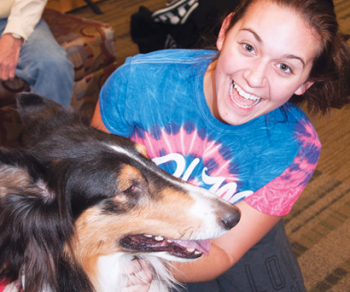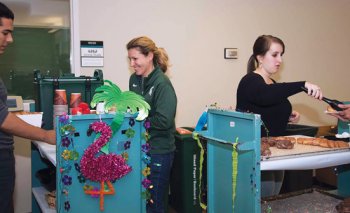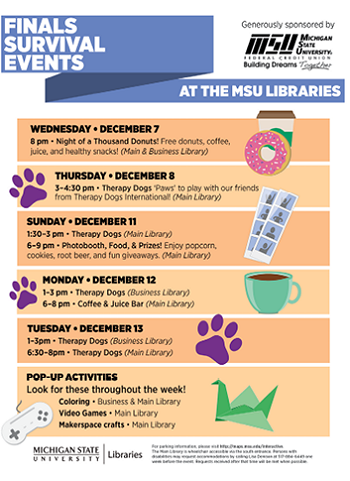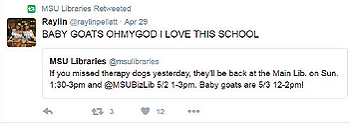 |
| This happy face shows the popularity of the therapy dog program. |
 |
| Librarians served coffee and donuts from colorfully decorated book trucks during the
Night of a Thousand Donuts. |
 |
| This poster outlines all of the finals-week activities in
December 2016. |
 |
| A student’s retweet expresses excitement at the prospect
of baby goats on the library patio. |
Academic libraries have long been the epicenter of stress on campuses during final-exams week. In recent years, librarians have begun offering stress-relieving activities as study breaks for students while they’re spending many long hours in our buildings. Therapy dogs, for instance, were first used to relax young readers in public libraries and then began making finals-week appearances in Ivy League universities around 2011. I work at MSU (Michigan State University) Libraries, and we began offering finals-week events in May 2012.
Michigan State, the nation’s first land-grant university, has a population of approximately 50,300 students; 39,000 of those are undergraduates from all over the world who are enrolled in more than 200 programs of study. MSU Libraries, with a collection of approximately 7 million volumes, is primarily housed in the 24-hour-a-day/5-day-a-week Main Library in the center of campus and in the smaller William C. Gast Business Library.
Inauspicious Beginnings
In 2010, I became the libraries’ first outreach coordinator. Before that, “outreach” mostly meant instruction librarians periodically staffing information fairs around campus. Prior to my
appointment, the libraries’ events were, appropriately, very academic in nature. The libraries hosted author readings, a film series, lectures on faculty research, and occasional environmental discussions. In many cases, a faculty member would approach the library about hosting a lecture and then invite his or her students for extra credit, and they comprised most of the audience. A film screening might attract a dozen participants, for instance. Since I started in outreach, we have worked deliberately over the years to introduce more fun events in order to promote a welcoming, inclusive environment. Public libraries in our area inspired me to start our own initiatives such as Blind Date With a Book and a Banned Books Read-Out. In the midst of enlivening our programming offerings, we also began to experiment with finals-week programming.
Prior to my starting in outreach, the library did not really do anything special for finals week other than stay open later on Friday and Saturday nights. We spent much of our time fielding complaints about the lack of study space and the building’s temperature, as well as occasionally mediating slight altercations between stressed-out students. Realizing that the library has, perhaps, more to offer as a huge building at that point in the semester than anything else, and that tired, hungry students do not achieve to the best of their ability, I began exploring how to help them.
My first foray into this was in May 2012, when a colleague and I opened the “stress-free zone,” an instruction room in which we had jump ropes, hula-hoops, active games such as cornhole, puzzles, snacks, and music. We kept it open and staffed all week from noon until 5 p.m. To promote it, we made fliers and displayed them by each elevator in the library. Neither one of us has a degree or any experience in advertising, communications, marketing, event planning, or graphic design. It showed. Unfortunately, only two students stopped in the entire week. Despite our failed program, we did at least learn a few things to help us in the future. The stress-free zone lacked effective marketing and student interest, and people were forced to leave their prized study spaces to use it.
Despite my lackluster beginnings, I continued to look for ways to relax our students during finals week. In late 2012, I began an environmental scan of what other Big Ten university libraries were doing. For several years prior, others had been bringing in therapy dogs for students to pet during study breaks. However, our library director was reluctant to allow dogs in. No other units at our university had live animal programming (despite having a veterinary medicine school on campus), and he was concerned about liability should something go wrong.
Not to be deterred, however, I researched other therapy dog programs in the state. I went to a Michigan Library Association workshop called “The Library as Place,” where I met colleagues from our main sports rival, the University of Michigan, who were doing similar stress-relief activities. While our football teams may try to crush each other, these librarians graciously shared all of the details I would need for a successful event (photo release forms, etc.). After much peer pressure from other library directors, our administration relented and approved our first therapy dog program. Previous outreach work had afforded me contacts in our Counseling Center, Career Services, and Admissions offices, where I knew people who owned therapy dogs, and they were just bursting to share their comforting pets with MSU students.
Early Success With Dogs and Donuts
We promoted the event with posters and on social media, but also relied heavily on students to spread the message themselves by texting their friends. The dogs in our Main Library were, as they are at most libraries, a huge success. Hundreds of students came, and every single one of them left energized and smiling.
Due to the success of the therapy dog events, and with our director now fully supportive of stress-relief efforts, we were able to add more events to our finals-week lineup. With our past experiences, good and bad, we knew that students liked animals, free food, and higher-quality entertainment than hula-hoops. The next semester (December 2014), we started the Night of a Thousand Donuts, in which 20 librarians loaded up book trucks with 83 dozen donuts, 40 gallons of coffee, and healthy snacks and pushed the bounty around the library in the middle of the night. (We included the Gast Business Library, so dogs and donuts were available in both locations.) Students were in shock at first, and then very grateful. We gave away 1,000 donuts in 56 minutes.
That led to even more events, beginning in May 2015. We had a Carnival Night, for which we hired a photo booth and ran a prize wheel; button-making in our makerspace; a huge coloring mural in our fine arts library; “random acts of pizza” delivered to our group study rooms; and, finally, baby goats on our patio in spring 2016. We have a steering committee of four people who plan the bulk of the events and a volunteer cohort of about 30 librarians to staff all of them.
Marketing Partners and Breakthroughs
After the first semester of dogs and donuts, which was highly successful but exhausting, I benefited from some positive developments that helped with the marketing and promotion of these events.
First, our development officer worked with the university’s credit union, which gave the library $10,000 for two semesters’ worth of programming. This not only paid for everything (thus alleviating any false ideas that we were spending the book budget on donuts), but also allowed us to do more paid print and web advertising.
For the fall 2014 semester, the library’s public services unit hired two former student workers who were instrumental in marketing our events. Both had just graduated from MSU, so they knew what students wanted and the most effective ways to communicate with our Millennial audience. Our new half-time social media coordinator, Katie, took over our Facebook page from me and gave it more than my lackluster attention. She increased our audience on Facebook, Twitter, and Instagram by a factor of 10. We also hired a graphic designer/photographer, Shelby, who designed professional-quality posters, table tents, and print and web ads and photographed each event in our lineup for future promotional opportunities. We displayed her posters in the library and also sent them to every bulletin board on every floor of all 25 residence halls (MSU has the largest residence hall system in the country).
Realizing that simply putting up posters in a library that is already crowded with too much signage was not effective in drawing an audience, I actively courted the media. A local television news show covered the therapy dogs as its lead story one evening. After that aired, reporters from both the local newspaper and Michigan Radio (NPR) visited and did stories on the dogs. The media coverage was 100% positive and accomplished two important goals: 1) Students who did not know about the events learned of them (sometimes through their parents, who saw the stories), and 2) the positive coverage helped persuade decision makers on campus that animal programs were worth the risk.
The library was the first unit on campus to have live animals (aside from service animals allowed through the Americans with Disabilities Act). The positive coverage helped convince our legal department of the value of our program, and it also spread the desire for therapy dogs across campus. After the television story aired, I fielded emails from several other units on campus that eventually all started their own therapy dog programs, including the student health center, residence halls, and the sexual assault program, among others.
Another marketing breakthrough we experienced at this time was embracing the initially scary idea of giving up some of the control to students. The stress-free zone was an utter failure in part because it was planned, advertised, and executed only by a very traditional academic librarian and me. Partly as an expression of my sometimes-stereotypical librarian type B personality (I don’t want to bother anyone else) and partly as a territorial reaction (“This is my library, and I know what works best here.”), that was the way I often planned events in those early days. However, when I collaborated with other units at MSU, we experienced our biggest successes. I found all of our therapy dogs through counselors on campus, who, in turn, spread the word about our events. We partnered with a fraternity to deliver the donuts. Not only were the members much more high energy than the librarians were that late at night, they also promoted the event to all of Greek Life, an audience that our in-house and residence hall posters may not have reached. In addition, we encouraged students to tweet their experiences with each event and provided some hashtags. Letting students control the message about our library was scary because I had no idea what they would say, but it was all very positive, and students seemed more apt to listen to each other than to us, the perceived authority figures. Finally, the campus tour guides have become unexpected allies; they tout the events to all the potential Spartans who visit campus with their families.
Assessment for Improvement
Our events have become more popular than ever because we continually assess every one, as well as its marketing campaign. We have feedback forms at each event that ask what the students thought of it and how they heard about it; the forms also ask for suggestions for other activities. While I have never asked anyone to fill them out, almost all of the students do because they are so thankful. Through the years, these forms guided us on what to offer (yoga was not popular) and where to advertise (no one saw the ad in the student newspaper). Answering the question, “How did you hear about this?” several students simply wrote, “It’s just known!”
Even though we have developed a slate of finals-week programming that is very popular and have determined the most effective ways to promote it, there is always room for improvement. In the future, I would like to earmark part of our budget for marketing (instead of spending bits of money here and there) and try some advertising spots we haven’t been able to afford yet, such as putting posters on campus buses, appearing on the residence hall cable channel, being in student-radio commercials, and more. I would also like to tie our finals-week marketing, which seems to reach a large student population, to library services and collections that would be useful to students during finals week, such as poster printing or reserving a group study lab. The more connections we can make with students and other units on campus, the more we serve the library’s mission! |